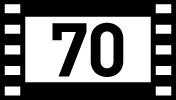

One of the most inspiring operations of World War II was the evacuation of Dunkirk, in which over 300,000 stranded Allied soldiers, surrounded by German troops and aircraft in the north of France, were rescued from the harbor of Dunkirk by a hastily assembled fleet of ships including hundreds of small civilian fishing boats, pleasure craft, yachts, and merchant marine vessels. Many feature films explore the profound significance of this “heroic retreat”—from William Wyler’s 1942 Best Picture Oscar winner Mrs. Miniver, made just one year after the operation itself, to the 1958 British war thriller Dunkirk, which recreates the events from the perspectives of a newspaper reporter in England (Bernard Lee) and a British soldier trapped in France (John Mills), to the 1964 French drama Weekend at Dunkirk, about a French soldier (Jean-Paul Belmondo) trying to join the British Navy's boat flotilla. More recently, there's been the celebrated single-take sequence in Joe Wright’s 2007 drama Atonement, which follows a wounded British soldier (James McAvoy) as he wanders the beach and comes to terms with the futility of his situation, and a trio of pictures released in 2017: Darkest Hour, which centers on England's Prime Minister Winston Churchill (Gary Oldman), the key decisions he made and speeches he gave at this crucial time of the war; Their Finest, a British wartime romantic comedy-drama about a young woman (Gemma Arterton) employed to write propaganda film scripts for the Ministry of Information, and Dunkirk, Christopher Nolan’s you-are-there 70mm IMAX extravaganza. Of all these pictures, Nolan’s aims highest in its attempt to become the definitive popular depiction of this event in our collective cultural imagination.
Nolan tells the story from three distinct points of view and timelines, giving each section of the film its own title and duration. “The Mole” takes place over the course of one week and follows two young soldiers (Fionn Whitehead and Aneurin Barnard) desperately trying to get off the beach, while the highest-ranking British officer at Dunkirk, the fictional Commander Bolton (Kenneth Branagh), is tasked with the unenviable duty of deciding which men will evacuate to safety and which will stay and die. “The Sea,” transpires over the course of one day and concerns a civilian fishing boat captain (Mark Rylance), his son (Tom Glynn-Carney), and a deckhand (Barry Keoghan), as they join the flotilla and make their way across the English Channel to join in the rescue of the trapped men. “The Air,” happens in just one hour and centers on two Air Force Pilots (Tom Hardy and Jack Lowden) on a mission to protect as many boats and aircraft as possible before running out of fuel.
The ambitious Dunkirk falls far short of movie greatness, but it easily ranks as the greatest movie-going experience of 2017—and possibly, if you have access to a theater that can properly project IMAX film, of the decade. It contains all the usual flaws of Nolan’s work, but in this case, the problematic aspects of his style and approach work in service of his artistic objectives, rather than inhibiting them. Countless filmmakers attain levels of narrative and thematic depth by telling their stories out of order, including masters like Orson Welles (Citizen Kane, 1941) and Akira Kurosawa (Rashomon, 1950), and contemporay directors like Quentin Tarantino (Pulp Fiction, 1994), and Alejandro Iñárritu (Amores Perros, 2000), but Christopher Nolan’s obsession with non-linear storytelling invariably exposes the hollowness of his pictures. From 1998’s Following, his first indie, to the feature that put him on the map, the psychological neo-noir Memento (2000), to the first in his trilogy of Dark Knight movies, Batman Begins (2005), the structure of his narratives either overpowers the inherent value of the story, or reveals itself as a mere gimmick in place of a fully developed plot, theme, or character
This issue of style over substance infects Dunkirk as well. The three segments and their real-time durations are introduced with on-screen titles—“The Mole, one week,” “The Sea, one day,” and “The Air, one hour”—before the first scene of each. Blink, and you might miss these titles. If audiences fail to catch these small pieces of text set in the corners of the giant IMAX images, and even if they do see them, they may completely fail to grasp the trifurcated time structure of the film. Nolan, as usual, intercuts his multiple narratives without any rhythmic, visual, auditory, thematic, or poetic motivation (or at least none that I can decipher after three viewings). The cuts come at random points, only serving to move us back and forth from one thread to another.
But in this film, unlike in Nolan’s more plot-driven pictures, a viewer’s potential confusion about the different occurrences, and the lack of any editorial motivation, does not inhibit appreciation of the movie. Dunkirk does not set out to tell a complete and contextualized account of this historic event. Rather, it places us directly into the viewpoints of the men on the ground, bombarding us with nearly every old-school cinematic tool to create the chaotic, frightening, futile experience of wartime terror. Though Dunkirk spares us the depiction of actual bloody combat found in films like Saving Private Ryan (1998) and Hacksaw Ridge (2016), it successfully evokes feelings of dread, panic, and desperation that soldiers in any war must feel.
Nolan could have structured his non-linear tale like a Pulp Fiction style triptych, which might have made for a more coherent picture. But there’s little denying that the random crosscutting of these three stories pulls the viewer into a moment-by-moment experience, never allowing us to pull back and consider the overall theater of battle from a comfortable, removed distance—just as the men on screen, even the pilots, are denied this luxury. The structure emphasizes the perceptions of each of the three perspectives on the Dunkirk evacuation—the perceptions of time, of duty, of camaraderie, and of what must to be done in each given situation.
Just as in The Dark Knight Rises, Nolan casts Tom Hardy as a character whose face is almost entirely obscured by a mask, making it hard to understand a third of what he says. In the case of Bane, in The Dark Knight Rises, this incomprehensible dialogue worked against the threatening presence of the central villain, often making him look and sound goofy instead of menacing. But our inability to catch everything Hardy’s Dunkirk pilot says adds both to the tension of the air sequences and our awareness about the limits of communication between airmen in a battle situation.
Nolan has always lacked the ability to create rich, dimensional characters for his complex plot machinations to serve. This deficit hobbles the intriguing The Prestige (2006), obliterates the laughable mind-bender plot of Inception (2010), and undercuts the otherwise exhilarating Interstellar (2014) with an overabundance of forced, saccharine sentimentality. Dunkirk is also guilty of placing the grandeur of its canvas over the individuality of the men on screen. Most the movies listed in the first paragraph of this essay do a far better job of humanizing the people affected by this military operation, to say nothing of the superiority of these pictures in providing some accurate historical sense of what happened at Dunkirk, and what it meant to the progression and ultimate outcome of WWII. But in terms of achieving Nolan’s specific objective for his Dunkirk movie—the primal sensations of what it must have felt like to be there—Dunkirk succeeds impressively.
Much of this success comes from the decision to shoot and release the picture in IMAX—specifically in the 70mm, 15-perforation wide celluloid format in which IMAX was originally developed. No feature-length narratives were produced in IMAX prior to the development of digital IMAX cameras and projectors. And the few non-documentary shorts made in celluloid IMAX—like Jean-Jacques Annaud’s Wings of Courage (1995)—are stiff, flat, and dull. The limitations caused by the size of the cameras, and the focus and lighting requirements of the film stocks, made exciting narrative IMAX features an unlikely proposition. But in the late ‘90s and ‘00s a trend began of blowing up major 35mm releases for IMAX theatrical presentation. Several filmmakers, Nolan in particular, began the practice of shooting certain sequences of their movies in IMAX, a bonus for audiences who paid the extra cash to see a picture in an IMAX theater.
But these IMAX sequences, while sometimes thrilling, always came across as gimmicks and invariably pulled viewers out of the story to place the focus on spectacle. The jarring shifts in color, clarity, film grain, and aspect ratio of these special sequences added a major level of discontinuity and distraction. The worst example of this trend was the IMAX release of Nolan’s The Dark Knight Rises (2012), which constantly switched back and forth between formats. Like most of the features released with special IMAX sequences, the majority of The Dark Knight Rises was shot in anamorphic widescreen 35mm, creating an extreme shift between the 2.39:1 aspect ratio of the letterboxed 35mm scenes and the 1.43:1 aspect ratio of the full frame IMAX sequences. And the amount of film grain visible in 35mm, especially when blown up to the larger format, made for a discordant comparison to the picture-window clarity of IMAX images printed right off their original camera negative. These IMAX releases resulted in a gimmicky distraction akin to a movie shot partially in 3D where superimposed text reading, “Put on your 3D glasses!” flashes onscreen right before a big action set piece or beautiful establishing shot is about to happen.
The multi-format technique is less troublesome in Dunkirk because the vast majority of the film was shot with IMAX 15/70 cameras, with only a little over twenty percent shot with standard 65mm cameras (where each frame of negative is about half the size of an IMAX 15/70 frame) using the same film stock. But the aspect ratio shifting is still an issue. Nolan only reverts to the smaller format for shots in tight spaces where IMAX cameras presumably would not fit. Many filmmakers would simply build a set capable of accommodating the required equipment, but for this historical period picture, Nolan wanted to shoot as much as possible on actual boats, planes, and locations. It is the same motivation that keeps Nolan’s movies relatively free of CGI effects, and places him at the head of the group of directors leading the fight to keep making and releasing their films on film. But his fidelity to shooting in as pure and traditional a style as feasible seems misplaced when it takes precedence over any commitment to producing a picture in a single, uniform format.
Of course, when seeing Dunkirk in the more widely available digital projection, as well as in 35mm, 70mm, or on DVD or HD streaming, many of these points become moot. All these formats present the film in a consistent 2.20:1 or 2.39:1 aspect ratio, with almost uniform lower resolution and grain. It’s only when viewing the movie in IMAX, and especially celluloid IMAX, that the shifts stand out drastically (The BluRay aspect ratio shifts between 1.78:1 and 2.20:1 with mildly noticeable color differences). You could avoid these inconsistencies by seeing the film in a standard presentation, but that would rob the picture of more than half its impact. Dunkirk best achieves its desired results when seen in 15/70 celluloid IMAX, in a theater with the largest screen and loudest sound you can find. The immersive experience is greater than anything ever achieved in 3D and anything I’ve yet seen in virtual reality. The fact that there is nothing between the audience and the images on the towering, 76x97 foot IMAX screen creates an intense, immediate, collective involvement that cannot be duplicated at home or through clumsy VR goggles.
Nolan’s Dunkirk may not be the definitive fictional telling of the historic defeat that helped the Allies secure their ultimate victory. It is an anecdotal work that shows us a precious few perspectives on an event that contains myriad stories and ramifications that still resound today. The film is a purely visceral, impressionistic experience designed to overwhelm viewers and place them in the random, presumptive boots of the brave but terrified men who fought in WWII. On that level, it’s a bloody good picture that should not be missed.
Twitter Capsule:








